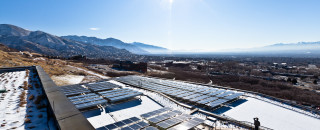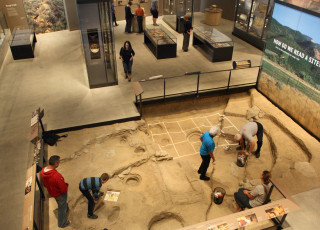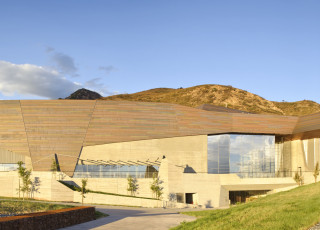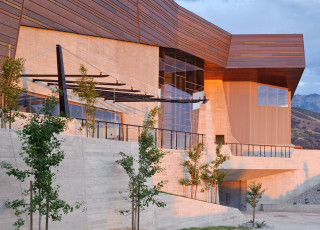New Solar Electric System Big Step toward U’s Carbon Neutral Goal
SALT LAKE CITY -- A new solar electric generation system installed at the University of Utah is another big step forward in the university’s goal to become more environmentally friendly and carbon neutral by the year 2050. The solar power arrays on the rooftop of the Natural History Museum of Utah’s Rio Tinto Center and the HPER East Building were unveiled to the public today at a press conference next to the museum’s solar array.
The Natural History Museum of Utah’s system is a 330-kilowatt system, while the HPER East system is a 263-kilowatt system. The combined arrays consist of 2,470 Sharp photovoltaic panels covering 40,000 square feet of rooftop space and together they will annually produce 802,240 kilowatt hours. Members of the public can get a unique, bird’s eye view of the Museum’s array — and learn about solar power — from the Museum’s Sky Terrace.
“Installing and making operational this solar system is a major accomplishment for the University of Utah and another important step toward fulfillment of our Energy and Environmental Stewardship Initiative created in 2010”, says Dr. David Pershing, president of the University of Utah. “Our climate action plan calls for campus to achieve carbon neutrality by the year 2050 and this goal will require many more such inventive projects in the years to come.”
Installation and commissioning of the systems was handled by Utah company Sustainable Power Group (sPower), which partnered with Okland Construction and Hunt Electric to complete the construction. The Sharp modules are American-made and manufactured in Memphis, Tennessee. BacGen Solar Group of Seattle provided consulting services throughout the project. McCalmont Engineering of Campbell, California designed and engineered the systems.
Under the terms of a Power Purchase Agreement (PPA), sPower will own and operate the systems for 20 years and sell the power to the University of Utah. This innovative third party ownership arrangement was made possible by the U.S. Department of Energy through the State of Utah Office of Energy Development and the Division of Facilities Construction and Management, which awarded a one million dollar American Recovery and Reinvestment Act renewable energy grant to the University. The university also received $125,000 through a Rocky Mountain Power Blue Sky program funding award.
The College of Architecture + Planning was integral in the process of securing a portion of the federal grant money and will directly benefit from the solar system. Electricity from both arrays will power the Architecture building in a project already underway to remodel the early 1970’s structure and achieve net-zero energy usage.
“The University’s green design leadership and commitment to use innovative energy financing strategies led to our selection of this project”, says Utah Division of Facilities Construction and Management Energy Director John Harrington. “The one million guests expected to annually visit the Museum of Natural History will have a unique opportunity to actually see this state-of-the-art rooftop system which demonstrates Utah’s commitment to renewable energy development.”
The EPA estimates that over the 20-year life of the system, the CO2 offset of the University’s new solar-energy system will be the equivalent of planting 28,368 tree seedlings or the amount of carbon sequestered by 2,360 acres of pine or fir forests.
The PPA that allowed the solar systems to be built is a bold new initiative involving university planners, strategists from the State of Utah Office of Energy Development and the Division of Facilities Construction and Management, the U.S. Department of Energy and the companies that were awarded the contracts.
“These projects are consistent with our long term relationship with the University of Utah. We consider this to be a showcase of how a public entity and private companies can work together to create sustainable energy, while at the same time saving the university money. The University of Utah has truly made a significant investment in securing a long term, clean and affordable energy source for the future,” says Ryan Creamer, CEO of sPower.
About the University of Utah: The University of Utah, located in Salt Lake City in the foothills of the Wasatch Mountains, is the flagship institution of higher learning in Utah. Founded in 1850, the university serves about 31,000 students from across the U.S. and the world, with over 72 major subjects at the undergraduate level and more than 90 major fields of study at the graduate level, including law and medicine. The University of Utah prepares students to live and compete in the global workplace.
About the University of Utah’s Energy and Environmental Stewardship Initiative: 2010 Climate Action Plan: In fall 2010, the university released its detailed long-range effort to make the campus more environmentally friendly and achieve carbon neutrality by the year 2050. The U.S. Environmental Protection Agency (EPA) recently ranked the University of Utah fourth in the nation for green power purchases. More information can be found at www.Unews.utah.edu.
Press contacts and links
-
Press Contact
Beth Mitchell



